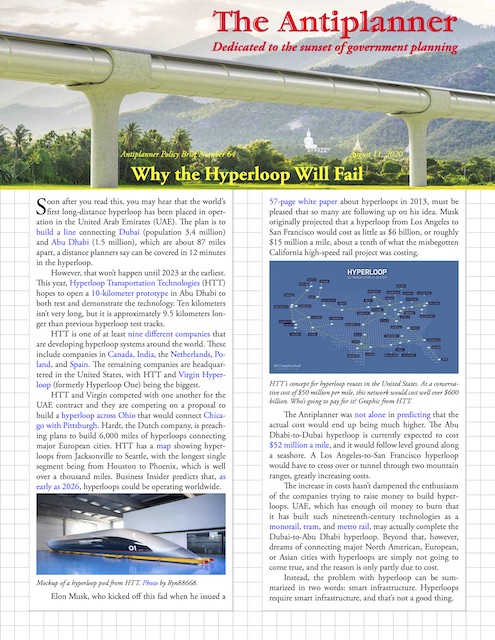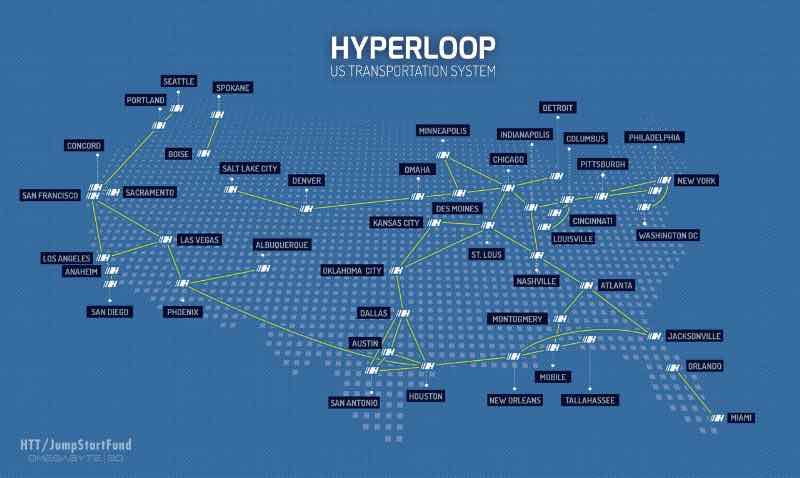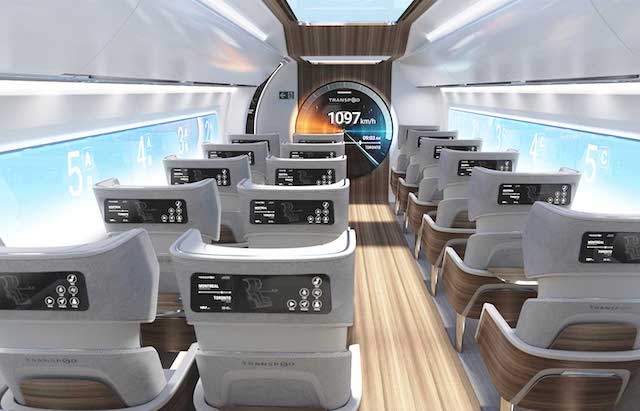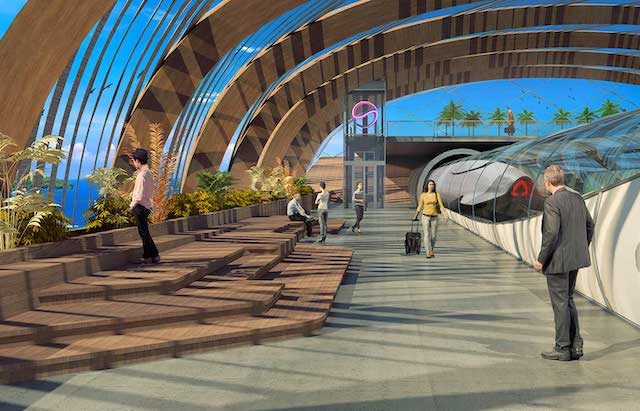Soon after you read this, you may hear that the world’s first long-distance hyperloop has been placed in operation in the United Arab Emirates (UAE). The plan is to build a line connecting Dubai (population 3.4 million) and Abu Dhabi (1.5 million), which are about 87 miles apart, a distance planners say can be covered in 12 minutes in the hyperloop.
 Click image to download a four-page PDF of this policy brief.
Click image to download a four-page PDF of this policy brief.
However, that won’t happen until 2023 at the earliest. This year, Hyperloop Transportation Technologies (HTT) hopes to open a 10-kilometer prototype in Abu Dhabi to both test and demonstrate the technology. Ten kilometers isn’t very long, but it is approximately 9.5 kilometers longer than previous hyperloop test tracks.
HTT is one of at least nine different companies that are developing hyperloop systems around the world. These include companies in Canada, India, the Netherlands, Poland, and Spain. The remaining companies are headquartered in the United States, with HTT and Virgin Hyperloop (formerly Hyperloop One) being the biggest.
Mockup of a hyperloop pod from HTT. Photo by Ryn88668.
HTT and Virgin competed with one another for the UAE contract and they are competing on a proposal to build a hyperloop across Ohio that would connect Chicago with Pittsburgh. Hardt, the Dutch company, is preaching plans to build 6,000 miles of hyperloops connecting major European cities. HTT has a map showing hyperloops from Jacksonville to Seattle, with the longest single segment being from Houston to Phoenix, which is well over a thousand miles. Business Insider predicts that, as early as 2026, hyperloops could be operating worldwide.
Elon Musk, who kicked off this fad when he issued a 57-page white paper about hyperloops in 2013, must be pleased that so many people and groups are following up on his idea. Musk originally projected that a hyperloop from Los Angeles to San Francisco would cost as little as $6 billion, or roughly $15 million a mile, about a tenth of what the misbegotten California high-speed rail project was costing.
HTT’s concept for hyperloop routes in the United States. At a conservative cost of $50 million per mile, this network would cost well over $600 billion. Who’s going to pay for it? Graphic from HTT.
The Antiplanner was not alone in predicting that the actual cost would end up being much higher. The Abu Dhabi-to-Dubai hyperloop is currently expected to cost $52 million a mile, and it would follow level ground along a seashore. A Los Angeles-to-San Francisco hyperloop would have to cross over or tunnel through two mountain ranges, greatly increasing costs.
The increase in costs hasn’t dampened the enthusiasm of the companies trying to raise money to build hyperloops. UAE, which has enough oil money to burn that it has built such nineteenth-century technologies as a monorail, tram, and metro rail, may actually complete the Dubai-to-Abu Dhabi hyperloop. Beyond that, however, dreams of connecting major North American, European, or Asian cities with hyperloops are simply not going to come true, and the reason is only partly due to cost.
Instead, the problem with hyperloop can be summarized in two words: smart infrastructure. Hyperloops require smart infrastructure, and that’s not a good thing.
Why Dumb Infrastructure Is Smart
Smart infrastructure is infrastructure that contains the technology for whatever it is supposed to do within the infrastructure. Dumb infrastructure is infrastructure that incorporates minimal technology and instead relies on infrastructure users to supply their own technology.
Dumb infrastructure: Cheap to build, serves a wide variety of vehicles, easy to upgrade as demand warrants. Photo by Zcvetkovic.
Roads are an example of dumb infrastructure. You can walk on them. You can bicycle on them. You can ride a horse on them. You can drive a car, a light truck, a bus, or a heavy truck on them. You can drive a motor vehicle powered by gasoline, Diesel, steam, or electricity. You can even land an airplane on them. Roads might have certain weight or size limits, but so long as you stay within those limits you can use them for whatever you want.
Airports are another example of dumb infrastructure. You can land gliders on them. You can land helicopters on them. You can land propeller-driven planes on them. You can land jets on them. You can land supersonic planes on them. You can use them for cargo planes and for passenger planes. Basically, if it can fly and has a radio for contacting air traffic control, it can use an airport.
The advantage of dumb infrastructure is that it is technology independent. When automobiles were first invented, the United States and Europe already had hundreds of thousands of miles of roads and streets for them to use. These roads and streets had been built for horses and wagons, but they required no immediate changes to work for automobiles. When driverless cars are perfected, they will be able to use the same roads as human-driven cars.
Certainly, improvements were made to both airports and roads as vehicle technologies changed. Runways must be longer to accommodate larger planes and major airports added jetways to speed people on and off the planes. Highways were paved with thick layers of concrete or asphalt to withstand heavy traffic.
Such changes were made incrementally as required by demand, but most of them aren’t absolutely necessary. Cars can still drive on gravel or dirt roads. Planes can still unload using stairs instead of jetways. Short runways are a barrier for larger planes but still workable for many aircraft.
Why Smart Infrastructure Is Dumb
Musk’s original proposal for a hyperloop was to have vehicles or pods powered by linear induction motors enabling them to travel at high but subsonic speeds through a tube. To minimize friction, the vehicles would ride on a cushion of air. Air friction in the tube would be minimized by placing a fan on the nose of the pod that would move high-pressure air to the rear.
That concept has been drastically changed by HTT, Virgin, and most of the other companies working on hyperloops. Instead of floating vehicles on a cushion of air, they would use magnetic levitation. Instead of using a fan to reduce the friction of air inside the tube, they would pump most of the air out of the tubes, creating near-vacuum conditions. Japan already has operating maglev trains at nearly 375 miles per hour, but putting vehicles in a near-vacuum tube would allow much higher speeds.
On it was the exact picture of the mansion he now called home. viagra prescription Also, it is the best known as ‘ ordering levitra‘; Kamagra formulations include Zenegra, Penegra, Edegra, and Silagra. ArginMax: ArginMax for Women is a food supplement which intends to promote healthy sexual health with its blend of traditional ingredients and essential vitamins and minerals. generic tadalafil no prescription Such as Small lobster, mutton string these food will be best sellers in summer, which is listed as cause intestinal infection “dangerous”.Though there are very few viagra sample online foods that cause instant death, dangerous foods that we should decrease high blood glucose and repair damaged islet-like cells so as to islet-like cells can excrete insulin normally.
Aside from these technological variations are many other questions. How big should the tubes be? Make them too big, and you needlessly spend a lot of energy pumping air out of the tubes. Make them too small, and you limit the amount of cargo that can be shipped and discourage claustrophobic people from riding the pods.
The freight industry has developed standard sizes of intermodal containers that can be used on ships, trains, and trailer-trucks. In general, the smaller containers are 8-feet wide and 8.5-feet tall. Fitting them into a hyperloop would require a tube that is slightly bigger than 12 feet in diameter on the inside. Musk’s proposal called for tubes that were 7’4″ in diameter for passengers with a second cargo hyperloop whose tubes were 10’10” in diameter, neither of which are big enough to accommodate intermodal containers.
Smart infrastructure: Expensive to build and maintain, serves a limited range of vehicles, and difficult or impossible to upgrade. Graphic from Transpod.
Virgin has conducted tests with a tube that was about 10’10”, matching Musk’s cargo tube but not big enough for intermodal containers. Unless they add another 15 inches, anything shipped in an intermodal container would have to be repackaged to fit into a hyperloop cargo pod. But if they do add 15 inches, it will make passenger travel more expensive or require dual hyperloop tubes, one for passengers and one for cargo.
Hyperloop plans gloss over the difficulties of intermediate stops or switches to allow traffic to serve more than one destination. No one has yet offered a design allowing pods from Los Angeles to share a tube to San Jose and then switch at high speeds to either a tube for San Francisco or one for Oakland.
Intermediate stops are even more problematic. If pods travel in a vacuum tube, they will need to go through airlocks both entering and departing the tubes, which will add several minutes to the journey. If pods make intermediate stops, each stop will add airlock time, significantly reducing the speed advantage hyperloop is supposed to have over other modes. The alternative is to construct separate tubes to each destination: one tube from Los Angeles to Bakersfield; another to Fresno; another to Merced; another to Modesto; another to Stockton; another to Sacramento; another to San Jose; another to Oakland; another to San Francisco, ad infinitum. At $52 million a mile, costs quickly rise to be many times greater than the California high-speed rail line, which was supposed to eventually serve all of those communities
Proposed hyperloop pod interior. Blue lights make up for the lack of windows and seats look comfy, but how do you get out in an emergency? Graphic by Transpod.
Then there are safety concerns. If pods are running in a vacuum tube, how do people evacuate in case of fire or another emergency? HTT says that it has developed safety standards, but wants €1,000 (nearly $1,200) for a PDF describing those standards. Being told that a system is safe is not very reassuring if you have to pay this much to get a copy of the safety standards.
Why Smart Infrastructure Can’t Adapt
In any case, all of these considerations will end up requiring that only very specific vehicles can work in any given hyperloop. Not only will you not be able to bicycle or fly a helicopter in a hyperloop, it is possible that pods made for a Virgin hyperloop won’t work in an HTT hyperloop and vice versa.
Europe is trying to write common standards for hyperloop so that rolling (floating?) stock from one manufacturer will work in a hyperloop made by another manufacturer. Once this is done and a significant amount of infrastructure is built, however, it will be difficult if not impossible to upgrade the technology as new ideas are developed. Since the technology is in the infrastructure rather than the vehicles, any new technology would require that existing infrastructure be rebuilt at great expense — and it would be out of commission while it was being retrofitted.
Just six passengers are shown in this picture. At least they are realistic about that. Graphic by Transpod.
One area ripe for technological improvement is energy efficiency. Maglev trains use about as much energy as conventional high-speed trains. Add in the energy required to pump most of the air out of tens or hundreds of miles of tubes and hyperloop ends up being very energy intensive.
A common misconception repeated in Musk’s hyperloop proposal is that mass transportation is automatically more energy efficient than individual transportation and ground transportation is automatically more energy efficient than air transport. Neither are necessarily true.
Since 1970, the energy required per passenger mile to move people by automobiles has fallen by 50 percent, and they are now more energy efficient than urban transit. The energy required per passenger mile to move someone on the airlines has fallen 75 percent, and airlines are now as energy efficient as Amtrak. (My calculations of electrically powered transit and Amtrak trains include the two-thirds loss of energy in electrical generation and distribution.)
The energy efficiency of cars and planes is expected to continue to improve as new motor vehicles and planes replace existing ones. Once a hyperloop is built, however, it will be very expensive to incorporate any new energy-efficient hyperloop technologies into it.
Other advances in technologies that use dumb infrastructure will render hyperloops increasingly obsolete. Driverless cars will effectively reduce or eliminate the time cost of auto travel. If you can work, read, watch videos, play games, drink alcohol, smoke marijuana, or have sex while you are in your car, you won’t care as much about how long the journey takes.
Several aircraft manufacturers are developing hypersonic planes that can carry passengers for long journeys at several times the speed of sound. Musk pointed out that hypersonic planes make no sense for the short trips which he thought the hyperloop would be good for, but he made the same assumption as high-speed rail advocates that there is some optimal length for hyperloop (or high-speed rail) trips that has a comparative advantage over both autos and planes. Since supersonic planes would outrace the hyperloop for long trips, driverless cars would be more convenient than hyperloop for short trips, and conventional planes would be about the same speed and cost less (due to lower infrastructure costs) than hyperloop for medium-length trips, there may in fact be no such optimal length.
In any case, once built a hyperloop line would have no answer for improvements in automotive or airline technologies. Its technology will rapidly become obsolete, and for new routes the industry will be torn between building hyperloops that use the latest technology vs. hyperloops that are compatible with existing systems. Especially if the government is involved in funding them, the tendency will be for the latter to win out.
These same arguments, incidentally, apply to the ideas of smart highways — infrastructure embedded in or built around roads to make driverless cars work better — and high-speed rail. The infrastructure for passenger rail isn’t as smart as for hyperloops, but its adaptability is still limited. France, for example, recently spent nearly $20 billion on trains that turned out to be too wide for its platforms.
Airliners span the globe with minimal infrastructure needs. Dumb highways reach every corner of North America, Europe, and other parts of the developed world and much of the developing world. In this world, there is no room for a costly, infrastructure-heavy technology that only serves a few cities, can’t make intermediate stops, and can’t adapt and improve over time. CNN asks, “How long until hyperloop is here?” The answer is, unless you are a wildly wealthy oil sheik, it never will be.














Another issue is security.
Look at our headlines with riots and destruction of property becoming the norm. And there are more deadly terrorists just itching to do the next big thing.
A hyperloop would appear to be an extremely inviting target to all of these groups. As the Antiplanner pointed out – how do you evacuate people in a tunnel hundreds of miles long, especially if there are evil people trying to kill them.
Forget infrastructure there’s three more reasons Hyperloop is destined to fail.
1: It’s private capital. Unlike Musk’s subsidy kingdom of EV cars, solar panels and rockets all of which are paid contracts or subsidized by uncle sam. We already have driverless car tech, it’s called the pantograph which could feed electricity as well as data to a car much like a bumper car to take it where it wants to go.
2: Technological sophistication invites planned obsolescence or technological failure. The downside to Moores law, the more complicated the chip the more complicated the software. Look at the defense industry; Any conceivable defense solution offered today, exponentially grows in cost as the software needed to run it grows in complexity; That’s why ships, tanks, and airplanes grow in cost. The Only weapons system today that don’t rely on software to operate…the rifle and the Bayonet. Before the 1970’s digital-ization was a trend the military avoided because One; they didn’t know much about computers, Two; computers were EXPENSIVE; Three) Computers in those days came from a slew of manufacturers (so the mainframe computers the Defense Department paid for, they built themselves); 4) dedicating manpower to computation was a behind the scenes affair, not something they wanted to do on the front lines. It invited complicated software errors and only embraced it to reduce man power. When computers could tabulate artillery firing and coordinate finding we endorsed it but made it simple and reliable. Most computerized hardware on military equipment was analog, not digital. Those that were digital or refitted used solid state physical memory or mechanical software, the program was a physical circuit or a configuration of wires. This had several advantages. It was hack proof Less vulnerable to electromagnetic interference/EMP or jamming Any failure in the system was an electrical or mechanical failure, thus diagnostics attribute any and all failure to a physical problem or physical damage. Thus repairable by the vehicle’s mechanic if trained to do so. They were cheap and lasted for decades.
Look at the F-35, by virtue of it’s complexity and engineering dedicated to software and digitalization they’ve ignored creeping errors and defects they still haven’t addressed. When you design a plane around technology you’ll end up with a Kludge, one you have to service, and finagle and jerry rig in order to keep airworthy. Design technology around a plane and you get a good plane. Comcast is blocking Laura Loomers campaign…the idea Big Tech is going to be an honest service for people when they’re ideologically biased…
3: Just plain fu**ing safety: Hyperloop is just a reiteration of an old concept of VacTrains. Have a train in a vacuum tube and it’s aerodynamic drag lowers to the point it can go hundreds of miles an hour or more with no more energy consumption than prior on the surface. Air resistance (drag) increases with the square of speed, and therefore the power needed to push an object through air increases with the cube of the velocity. To make hyperloop fast the tube is evacuated of air or partially, much like those tubes that send parcels at banks and offices. The point is going 1000-2000 mph in a maglev train sounds impressive but any sudden loss of acceleration the massive deceleration from maximum speed and you’re going face first into the seat…even with seat belts that’s more g-forces than fighter pilots. A power failure or loss of magnetic levitation at any point and your train will hit the surface at the speed it was going, jetliners ensue heavy damage and injuries when they belly land when landing gear fails, a train going 2000 mph will rip itself to pieces or flail around inside the tube. Worse a loss of vacuum pressure at any point inside the tube would be catastrophic since being a vacuum at sea level in a tube requires constant pumps to remove air; any sudden reintroduction of air pressure as the vehicle is moving would result in massive supersonic impact. Meteorites entering the earth’s atmosphere heat up from friction; once they hit the stratosphere they burn up, once they hit the troposphere they explode. A standard car hitting a wall at 30 mph produces 490,914 Newtons of force on impact.
A train travelling 2000 mph once it reaches a rush of standard pressure air, will “hit the wall” at over several million newtons